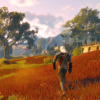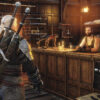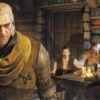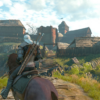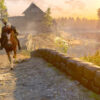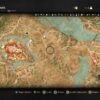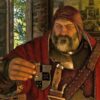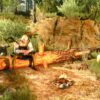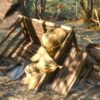New screenshots have appeared for CD Projekt Red’s upcoming Witcher sequel, The Witcher 3: Wild Hunt. You can see part of the world map for the open-world roleplaying game below, and more in-game images further down. Note that these captures aren’t of the best quality, as they appear to be compressed and/or scans, so don’t panic—this isn’t evidence of the rumored graphical downgrade.
Also, over on CD Projekt’s forums, level designer Miles Tost answered some questions. We’ve collected the material bits below:
Overworld
The more avid Witcher fans will notice that the map of the game world differs from the world in Andrzej Sapkowski’s books.
Tost explains the reason for this: they wanted the world to be believable but “sailing for 30-40 minutes in a straight line to reach one of the other Skellige Isles is not really a lot of fun [and] since we’re making a game about Geralt the Monster Hunter and not Geralt the Sailor, we actually had to go out and move entire islands, including content, closer to each other.” This philosophy extended to the rest of the world, too, so the playable areas have been squashed together. However, wrote Tost, the “world is reaaally big”.
Settlements
In reply to a question, Tost wrote that he always kept in mind that the human cities in The Witcher are built on top of elven ones, and that he would “pester people whenever there was a chance for it. Without going into further detail, all I can say so far is: mission successful.”
Tost discussed Novigrad, the free city of Redania, rather extensively. None of the houses in the city have been placed procedurally—”the city was carefully planned and crafted all the way from the rough districts to individual pathways in between (or through) houses”—and more than a third of the houses in Novigrad are accessible, according to Tost. “I feel like you’d be surprised just how accessible the city is. MANY open buildings. Don’t have an exact number, but it exceeds a hundred by far.”
Tost also officially and unequivocally confirmed that the city of Oxenfurt is in the game.
About Skellige, he wrote the following: the region of Skellige will have a mix of large settlements and small villages, distributed not just on the main island but also on the smaller islands. “There’s more to the open sea than the main islands of the Skellige Archipelago,” he added.
Skellige could have been significantly different than its literary counterpart. “We had planned a farmstead to support the ‘believable infrastructure’ thing, which we ultimately ended up removing [because] the Story Team told us, ‘Skelligers are not farmers. They pillage and take what they need.’ (We ended up replacing the crop farms with cattle farms—Skelligers still need meat, after all!)”
Wild Hunt‘s prologue will take place in Kaer Morhen, mirroring the original Witcher game. “Is it just a prologue place or [do we return] and explore,” Tost teased, “Maybe a secret door, with a secret book, with a secret sword, and a secret story (at least as DLC)? Fully explorable region. And no, I’m not just speaking of the castle.”
Gameplay
Geralt will be a lot more nimble than he has been in previous games: he’ll be able to jump and climb wherever it would be physically possible for him to do so. “As long as Geralt can reach it, you should” be able to climb it, says Tost.
Unlike previous Witchers, The Witcher 3 will allow Geralt to use torches. This will be useful should players not have a Cat Potion to hand, or if they have already reached their toxicity threshold. Players “can even fight while wielding the torch in one hand”, says Tost, although they are unable to parry attacks while fighting like this.
Players will also be able to create gas clouds, which they can ignite with “certain kinds of bombs. Some bombs will also attract monsters through smell, which can be an asset to the player as well.”
Ciri’s gameplay sections will be “a lot more linear in their design” but “they are only like that when you play as Ciri, and some of them later can be freely explored by the player as Geralt. In terms of making this feel believable, it’s helpful that Ciri never got the hang of weaving signs.”
Outtakes
“We actually used to have […] perks / potions to increase jump distance or increase the amount of time you can spend underwater. It was really tough to design locations with this in mind, without having players that [chose] a different skill-path feel like they’re [missing] out. Also balancing it got to be a problem, as increasing the jump distance of players through skillpoints meant that the player now could suddenly reach an uncountable amount of new places, which the player shouldn’t be able to reach (locations that open through quests, for example). Lastly, the design didn’t really fit with the schedule. You either make a lot of these ‘special’ places, only reachable with the perk, but then you have even more content the other players might feel left out from; [or you] make less of the content and the perk doesn’t feel worth investing in anymore. So instead, we counted our losses and we opted to just make more content for everyone to enjoy.”
That’s all for now. However, CD Projekt Red did recently reveal more details about the game, and a new gameplay walkthrough, so check those out if this article wasn’t enough of a fix.
The Witcher 3: Wild Hunt will be available worldwide on May 19 for Windows PCs, Playstation 4s, and Xbox Ones.
(Thanks, NeoGAF.)

